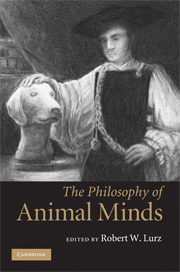Book contents
- Frontmatter
- Contents
- List of contributors
- Acknowledgments
- The philosophy of animal minds: an introduction
- 1 What do animals think?
- 2 Attributing mental representations to animals
- 3 Chrysippus' dog as a case study in non-linguistic cognition
- 4 Systematicity and intentional realism in honeybee navigation
- 5 Invertebrate concepts confront the generality constraint (and win)
- 6 A language of baboon thought?
- 7 Animal communication and neo-expressivism
- 8 Mindreading in the animal kingdom
- 9 The representational basis of brute metacognition: a proposal
- 10 Animals, consciousness, and I-thoughts
- 11 Self-awareness in animals
- 12 The sophistication of non-human emotion
- 13 Parsimony and models of animal minds
- 14 The primate mindreading controversy: a case study in simplicity and methodology in animal psychology
- Glossary of key terms
- References
- Index
6 - A language of baboon thought?
Published online by Cambridge University Press: 05 June 2012
- Frontmatter
- Contents
- List of contributors
- Acknowledgments
- The philosophy of animal minds: an introduction
- 1 What do animals think?
- 2 Attributing mental representations to animals
- 3 Chrysippus' dog as a case study in non-linguistic cognition
- 4 Systematicity and intentional realism in honeybee navigation
- 5 Invertebrate concepts confront the generality constraint (and win)
- 6 A language of baboon thought?
- 7 Animal communication and neo-expressivism
- 8 Mindreading in the animal kingdom
- 9 The representational basis of brute metacognition: a proposal
- 10 Animals, consciousness, and I-thoughts
- 11 Self-awareness in animals
- 12 The sophistication of non-human emotion
- 13 Parsimony and models of animal minds
- 14 The primate mindreading controversy: a case study in simplicity and methodology in animal psychology
- Glossary of key terms
- References
- Index
Summary
INTRODUCTION
Does thought precede language, or the other way around? How does having a language affect our thoughts? Who has a language, and who can think? These questions have traditionally been addressed by philosophers, especially by rationalists concerned to identify the essential difference between humans and other animals. More recently, theorists in cognitive science, evolutionary biology, and developmental psychology have been asking these questions in more empirically grounded ways. At its best, this confluence of philosophy and science promises to blend the respective strengths of each discipline, bringing abstract theory to bear on reality in a principled and focused way. At its worst, it risks degenerating into a war of words, with each side employing key expressions in its own idiosyncratic way – or worse, contaminating empirical research with a priori dogmas inherited from outmoded philosophical worldviews.
In Baboon Metaphysics (2007), Dorothy Cheney and Robert Seyfarth offer an analysis of baboon cognition that promises to exemplify the very best interaction of philosophical theory and empirical research. They argue that baboons have a language of thought: a language-like representational medium, which supports the sophisticated cognitive abilities required to negotiate their complex social environment. This claim is intended to be surprising in its own right, and also to shed light on the evolution of spoken language. Because our own ancestors likely lived in a similarly complex social environment, Cheney and Seyfarth propose that the earliest humans also developed language first as a cognitive medium, and that spoken language evolved as a means to express those thoughts.
- Type
- Chapter
- Information
- The Philosophy of Animal Minds , pp. 108 - 127Publisher: Cambridge University PressPrint publication year: 2009
- 54
- Cited by

